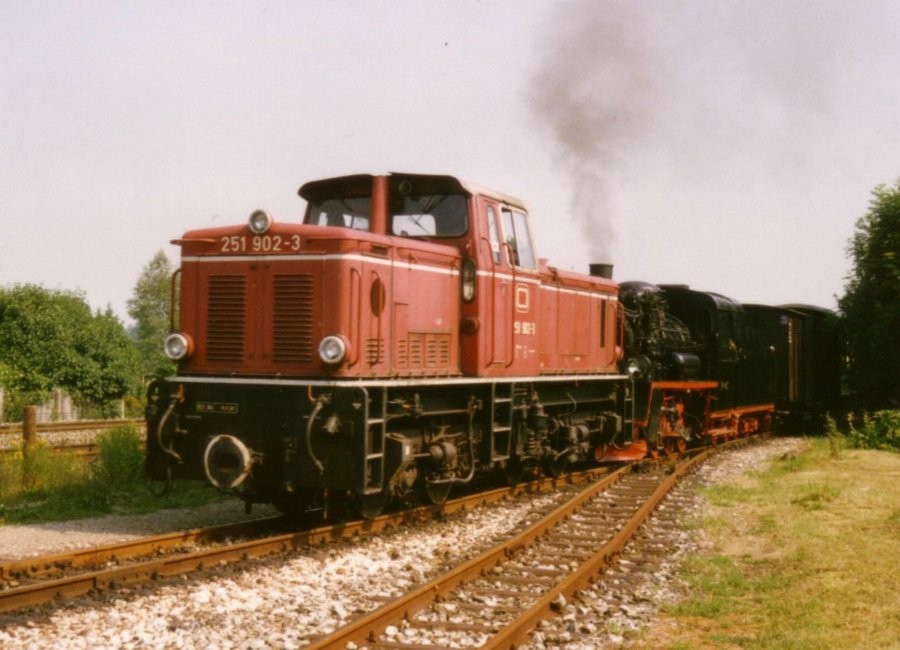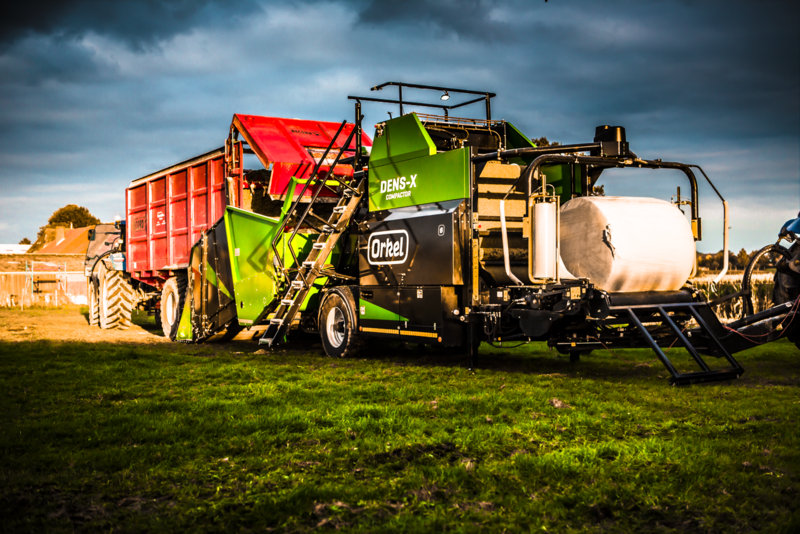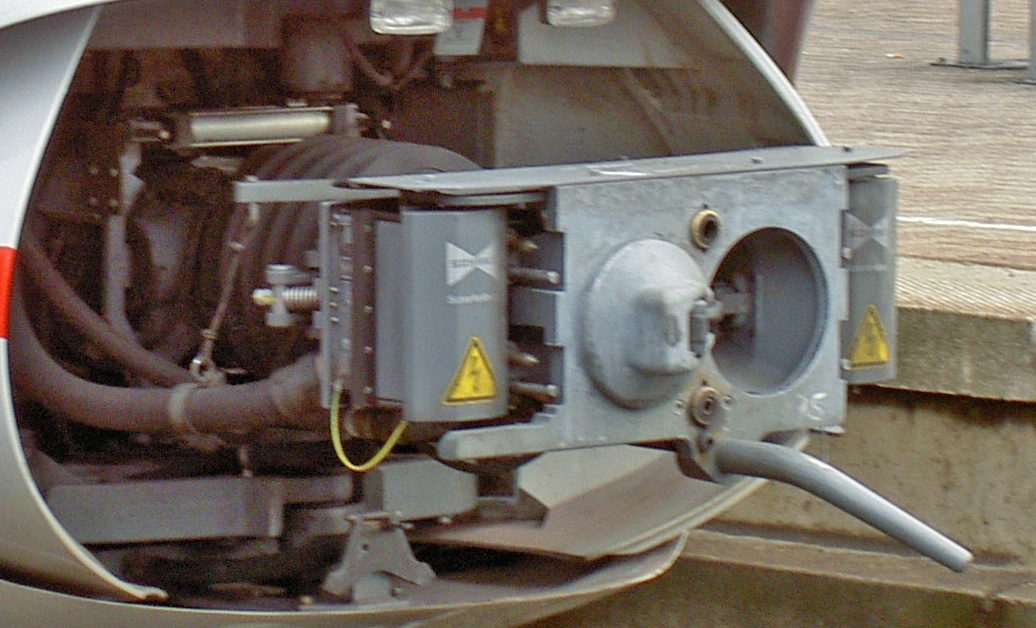|
WEG T 23 And 24
The Class T 23 and 24 are diesel railbuses which were procured by the Württemberg Railway Company (WEG) and then operated by the Westerwald Railway (WEBA) until 2009 on the Daade Valley Railway and now belong to the Krumbach IGEBA engineer society railway. The WEG had the two railbuses built in 1968 at Gmeinder and Auwärter for working the branch line from Nürtingen to Neuffen. They were powered by two Büssing engines with a power of 154 kW (210 PS) each. Each motor drove an axle via a Voith 501 drive. Their control system enabled them to be used as a pair. The two new railbuses hauled heavy limestone trains between a quarry near Neuffen and a cement works in Nürtingen. In order to simplify shunting operations, the WEG fitted the two railbuses and the two end wagons of the limestone trains with Scharfenberg couplers. After the transportation of limestone was ended in October 1979, the two railbuses lost their original operating route and, on 3 Octob ... [...More Info...] [...Related Items...] OR: [Wikipedia] [Google] [Baidu] |
Gmeinder
Gmeinder GmbH was a German locomotive and engineering company based in Mosbach. Its products included diesel engines, small locomotives (shunters) and other railway locomotive parts. Much of its business came through the German railways, though it also exported to the rest of Europe and the rest of the world. From 2004 onwards the company was split into two separate concerns - Gmeinder Lokomotivenfabrik which manufactures locomotives and Gmeinder Getriebe- und Maschinenfabrik which makes components - specifically railway axle gearboxes. History In 1913 The company Steinmetz Gmeinder KG was founded in Mosbach by Anton Gmeinder and August Steinmetz, six years later the company name was changed to "A. Gmeinder & Cie.". The same year a locomotive with a petrol engine was made. In 1925 another change of identity occurred - with the organisation becoming Gmeinder & Co. GmbH with Anton Gmeinder and Carl and Hermann Kaelble as co-partners. In 1964 with financial support from the state o ... [...More Info...] [...Related Items...] OR: [Wikipedia] [Google] [Baidu] |
Cement Works
A cement is a binder, a chemical substance used for construction that sets, hardens, and adheres to other materials to bind them together. Cement is seldom used on its own, but rather to bind sand and gravel ( aggregate) together. Cement mixed with fine aggregate produces mortar for masonry, or with sand and gravel, produces concrete. Concrete is the most widely used material in existence and is behind only water as the planet's most-consumed resource. Cements used in construction are usually inorganic, often lime or calcium silicate based, which can be characterized as hydraulic or the less common non-hydraulic, depending on the ability of the cement to set in the presence of water (see hydraulic and non-hydraulic lime plaster). Hydraulic cements (e.g., Portland cement) set and become adhesive through a chemical reaction between the dry ingredients and water. The chemical reaction results in mineral hydrates that are not very water-soluble and so are quite durable in ... [...More Info...] [...Related Items...] OR: [Wikipedia] [Google] [Baidu] |
Westerwald
The Westerwald (; literally 'Western forest') is a low mountain range on the right bank of the river Rhine in the German federal states of Rhineland-Palatinate, Hesse and North Rhine-Westphalia. It is a part of the Rhenish Massif ( or Rhenish Slate Mountains). Its highest elevation, at 657 m above sea level, is the Fuchskaute in the High Westerwald. Tourist attractions include the (394 metres), site of some Celtic ruins from La Tène times (5th to 1st century BC), found in the community of the same name, and Limburg an der Lahn, a town with a mediaeval centre. The geologically old, heavily eroded range of the Westerwald is in its northern parts overlaid by a volcanic upland made of Neogene basalt layers. It covers an area of some , and therefore roughly , making the Westerwald one of Germany's biggest mountain ranges by area. In areas of subsidence, it has in its flatter western part (Lower Westerwald) the characteristics of rolling hills. Typical for the economy ... [...More Info...] [...Related Items...] OR: [Wikipedia] [Google] [Baidu] |
Wacker Plate
A compactor is a machine or mechanism used to reduce the size of material such as waste material or bio mass through compaction. A trash compactor is often used by a home or business to reduce the volume of trash it produces. A baler-wrapper compactor is often used for making compact and wrapped bales in order to improve logistics. Normally powered by hydraulics, compactors take many shapes and sizes. In landfill sites for example, a large tractor (typically a converted front end loader with some variant of a bulldozer blade attached) with spiked steel wheels called a landfill compactor is used to drive over waste deposited by waste collection vehicles (WCVs). WCVs themselves incorporate a compacting mechanism which is used to increase the payload of the vehicle and reduce the number of times it has to empty. This usually takes the form of hydraulically powered sliding plates which sweep out the collection hopper and compress the material into what has already been loaded. ... [...More Info...] [...Related Items...] OR: [Wikipedia] [Google] [Baidu] |
DB Class 628
The DB Class 628 is a twin-car, diesel multiple unit operated by the Deutsche Bahn for local passenger rail services. Design ''(The following description is primarily related to the Class 628.4, and is largely valid for the other variants as well)'' Each coach rests on two twin-axle bogies. Only the bogie at the close-coupled end of the coach is driven. Power transmission from the motor is achieved using a ''Voith'' hydrodynamic transmission system with a converter (''Wandler'') and a T 311r coupling. Up to Class 628, a T 320 double-converter transmission was used. Motor and transmission are suspended elastically under the lightweight coach body. The operating brake is an automatic compressed air KE disc brake with automatic load braking and electronic anti-skid protection. In addition, for rapid braking, electromagnetic rail brakes are used; these can also be activated separately if required. Coupled running enables up to four coupled pairs of coaches to be driven from one dri ... [...More Info...] [...Related Items...] OR: [Wikipedia] [Google] [Baidu] |
Daaden
Daaden is a municipality in the district of Altenkirchen, in Rhineland-Palatinate, Germany. It is situated in the Westerwald, approx. 15 km south-west of Siegen. Daaden is the seat of the ''Verbandsgemeinde A Verbandsgemeinde (; plural Verbandsgemeinden) is a low-level administrative unit in the German federal states of Rhineland-Palatinate and Saxony-Anhalt. A Verbandsgemeinde is typically composed of a small group of villages or towns. Rhinelan ...'' ("collective municipality") Daaden-Herdorf. References External links * (German) Altenkirchen (district) {{Altenkirchen-geo-stub ... [...More Info...] [...Related Items...] OR: [Wikipedia] [Google] [Baidu] |
Betzdorf, Germany
Betzdorf is a town and municipality in northern Rhineland-Palatinate, Germany. Betzdorf is part of the district of Altenkirchen. Betzdorf is located on the river Sieg, approx. south-west of Siegen. Betzdorf is the seat of the ''Verbandsgemeinde'' Betzdorf-Gebhardshain. Betzdorf (Sieg) station is a railway junction with closed marshalling yard on the Sieg Railway, the Betzdorf–Haiger railway and the . It is twinned with the town of Ross-on-Wye, England England is a country that is part of the United Kingdom. It shares land borders with Wales to its west and Scotland to its north. The Irish Sea lies northwest and the Celtic Sea to the southwest. It is separated from continental Europe b .... References Altenkirchen (district) {{Altenkirchen-geo-stub ... [...More Info...] [...Related Items...] OR: [Wikipedia] [Google] [Baidu] |
Driving Trailer
A control car, cab car (North America), control trailer, or driving trailer (UK and Ireland) is a non-powered rail vehicle from which a train can be operated. As dedicated vehicles or regular passenger cars, they have one or two driver compartments with all the controls and gauges required to remotely operate the locomotive, including exterior locomotive equipment such as horns, bells, ploughs, and lights. They also have communications and safety systems such as GSM-R or European Train Control System (ETCS). Control cars enable push-pull operation when located on the end of a train opposite its locomotive by allowing the train to reverse direction at a terminus without moving the locomotive or turning the train around. Control cars can carry passengers, baggage, and mail, and may, when used together with diesel locomotives, contain an engine-generator set to provide head-end power (HEP). They can also be used with a power car or a railcar. European railways have used control ... [...More Info...] [...Related Items...] OR: [Wikipedia] [Google] [Baidu] |
Railway Coupling
A coupling (or a coupler) is a mechanism typically placed at each end of a railway vehicle that connects them together to form a train. A variety of coupler types have been developed over the course of railway history. Key issues in their design include strength, reliability, ease of making connections and operator safety. The equipment that connects the couplings to the vehicles is the draft gear or draw gear and these must absorb the stresses of coupling and train acceleration. Nomenclature Compatible and similar couplings or couplers are frequently referred to using widely differing make, brand, or regional names, or nicknames, which can make describing standard or typical designs confusing. Dimensions and ratings noted in these articles are usually of nominal or typical components and systems, though standards and practices also vary widely with railway, region, and era. Buffers and chain The basic type of coupling on railways following the British tradition is the bu ... [...More Info...] [...Related Items...] OR: [Wikipedia] [Google] [Baidu] |
Lower Kocher Valley Railway
{{Disambiguation ...
Lower may refer to: * Lower (surname) * Lower Township, New Jersey *Lower Receiver (firearms) * Lower Wick Gloucestershire, England See also *Nizhny Nizhny (russian: Ни́жний; masculine), Nizhnyaya (; feminine), or Nizhneye (russian: Ни́жнее; neuter), literally meaning "lower", is the name of several Russian localities. It may refer to: * Nizhny Novgorod, a Russian city colloquial ... [...More Info...] [...Related Items...] OR: [Wikipedia] [Google] [Baidu] |
Scharfenberg Coupler
The Scharfenberg coupler (german: Scharfenbergkupplung, abbreviated ''Schaku'') is a commonly used type of fully automatic railway coupling. Designed in 1903 by Karl Scharfenberg in Königsberg, Germany (today Kaliningrad, Russia), the coupler has gradually spread from transit trains to regular passenger service trains, although outside Europe its use is generally restricted to mass transit systems. The ''Schaku'' is superior in many ways to the AAR (Janney/knuckle) coupler because it also automates electrical and pneumatic connections and disconnections. However, there is no standard for the placement of these electro-pneumatic connections. Some rail operators have placed them on the sides while others have placed them either below or above the mechanical portion of the coupler. . Working principles The face of the Scharfenberg coupler has a protruding cone and a matching cup. Inside the cone there is a rigid metal hoop connected to a revolving, spring-loaded metal disk with a ... [...More Info...] [...Related Items...] OR: [Wikipedia] [Google] [Baidu] |
Shunting (rail)
Shunting, in railway operations, is the process of sorting items of rolling stock into complete trains, or the reverse. In the United States this activity is known as switching. Motive power Motive power is normally provided by a locomotive known as a ''shunter'' (in the UK) or switcher (in the US). Most shunter/switchers are now diesel-powered but steam and even electric locomotives have been used. Where locomotives could not be used (e.g. because of weight restrictions) shunting operations have in the past been effected by horses or capstans. Hazards Coupling The terms "shunter" and "switcher" are applied not only to locomotives but to employees engaged on the ground with shunting/switching operations. The task of such personnel is particularly dangerous because not only is there the risk of being run over, but on some railway systems—particularly ones that use buffer-and-chain/screw coupling systems—the shunters have to get between the wagons/carriages in order to ... [...More Info...] [...Related Items...] OR: [Wikipedia] [Google] [Baidu] |




.jpg)





.jpg)